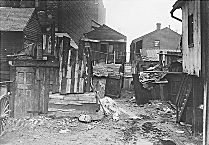| Rear Houses | ||
During the 1880s in neighborhoods near the Loop where land values rose dramatically, the crowding of two and even three cottages upon a single lot became profitable for immigrant homeowners. In districts where factories displaced residences, landowners purchased old cottages intended for demolition. Without permanent foundations or plumbing, these structures were raised and moved easily to another location, often the rear portion of a lot. In other instances, landowners moved older cottages from the front to the rear of their lots and then constructed larger brick buildings on the front of the lot.
| ||
Chicago - City of Broad Shoulders
This course is about Chicago, We will cover the history of the city and region, the politics, corruption, arts, plans, neighborhoods, humor, achievements and the future of the City.

